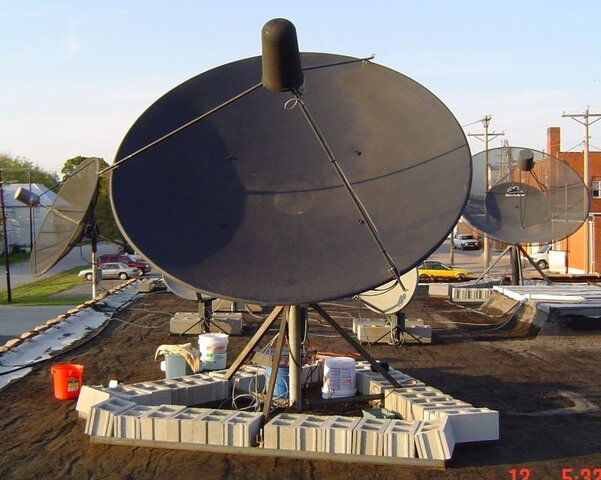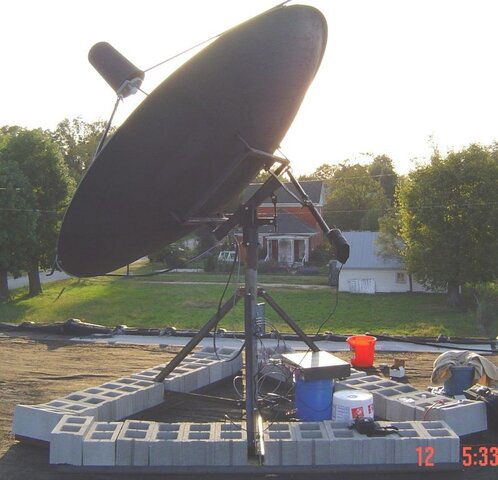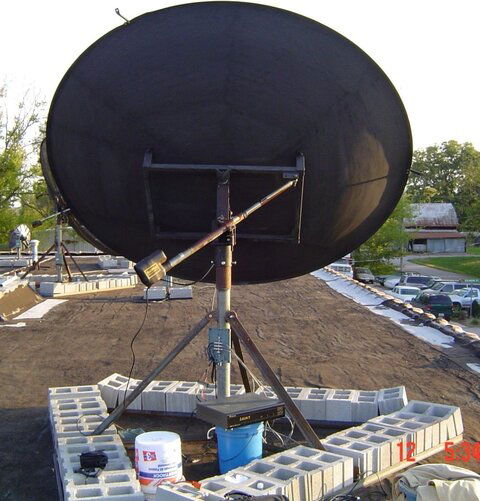Started working on tuning this BUD Thursday afternoon. Spent about 4 hours just getting everything working properly. I soon realized that I would need an A/B video switch because of all the back and forth between the Legacy and Traxis receivers. Very slow start on Thursday.
Went to the Rat Shack and picked up a switch Thursday evening, and started again on Friday morning. My calculations were only about a half inch or so off, and F/D appears to be around .40 at least that is where I am getting my best signal.
This dish is like the Birdview in that it has a built in declination of about 4.5 - 5 degrees. For my location, I need about 5.5 degrees. So for today, I am going to have to fight the two top bolts loose on the rectangular mount and make some shims to fit between the mount and the dish to give me the extra declination I need.
The A/B switch is a life saver, but it is still a struggle fighting with the Legacy for skew and movement while watching the SQ on the Traxis.
The numbers so far are not very impressive, but I think will improve with the declination.
G15 (133W) C-Band several TPs - 70% SQ I haven't been able to tune in the California Channel yet. Analog is maxed out on the Legacy meter, but that doesn't mean much for digital. I get the CA channel at 45% on the Pansat/BV combo.
G11 (91W) C-Band TP 1 - 80% SQ This is at 90% on the PS/BV
G11 (91W) Ku-Band Bell test card - 45% SQ - 75% on PS/BV
G17 (74W) Ku ONN is at 80% SQ - maxed out on the PS/BV
AMC6 (72W) C-Band NASA digital is at 70% SQ - about the same on PS/BV
AMC6 (72W) Ku I am having some trouble pulling C-Band through the Ku side. I think I have setup the wrong Ku satellite format for that one. Will have to work on that.
As I said, the numbers aren't real impressive on the Traxis. I am not yet used to it's meter, and it may be a little more conservative than the Pansat. It's threshold for picture is higher than the Pansat. Seems to pixelate a little below 45% SQ.
I was so tempted to just unhook the Pansat and use it for the fine tune, but if I don't get used to the Traxis, I never will be able to use it for tuning.
I may be wrong, but I think it will be a fine performer once everything is tuned in.
Here are a few pics of the final setup.




If someone has some experience with using the Pansat 3500 and the Traxis, and can tell me how the numbers on the meter are similar or different, can you please post your experience?
Now I have to go fight with two rusty bolts. HeHe
HeHe
Thanks,
Fred
Went to the Rat Shack and picked up a switch Thursday evening, and started again on Friday morning. My calculations were only about a half inch or so off, and F/D appears to be around .40 at least that is where I am getting my best signal.
This dish is like the Birdview in that it has a built in declination of about 4.5 - 5 degrees. For my location, I need about 5.5 degrees. So for today, I am going to have to fight the two top bolts loose on the rectangular mount and make some shims to fit between the mount and the dish to give me the extra declination I need.
The A/B switch is a life saver, but it is still a struggle fighting with the Legacy for skew and movement while watching the SQ on the Traxis.
The numbers so far are not very impressive, but I think will improve with the declination.
G15 (133W) C-Band several TPs - 70% SQ I haven't been able to tune in the California Channel yet. Analog is maxed out on the Legacy meter, but that doesn't mean much for digital. I get the CA channel at 45% on the Pansat/BV combo.
G11 (91W) C-Band TP 1 - 80% SQ This is at 90% on the PS/BV
G11 (91W) Ku-Band Bell test card - 45% SQ - 75% on PS/BV
G17 (74W) Ku ONN is at 80% SQ - maxed out on the PS/BV
AMC6 (72W) C-Band NASA digital is at 70% SQ - about the same on PS/BV
AMC6 (72W) Ku I am having some trouble pulling C-Band through the Ku side. I think I have setup the wrong Ku satellite format for that one. Will have to work on that.
As I said, the numbers aren't real impressive on the Traxis. I am not yet used to it's meter, and it may be a little more conservative than the Pansat. It's threshold for picture is higher than the Pansat. Seems to pixelate a little below 45% SQ.
I was so tempted to just unhook the Pansat and use it for the fine tune, but if I don't get used to the Traxis, I never will be able to use it for tuning.
I may be wrong, but I think it will be a fine performer once everything is tuned in.
Here are a few pics of the final setup.




If someone has some experience with using the Pansat 3500 and the Traxis, and can tell me how the numbers on the meter are similar or different, can you please post your experience?
Now I have to go fight with two rusty bolts.
Thanks,
Fred

